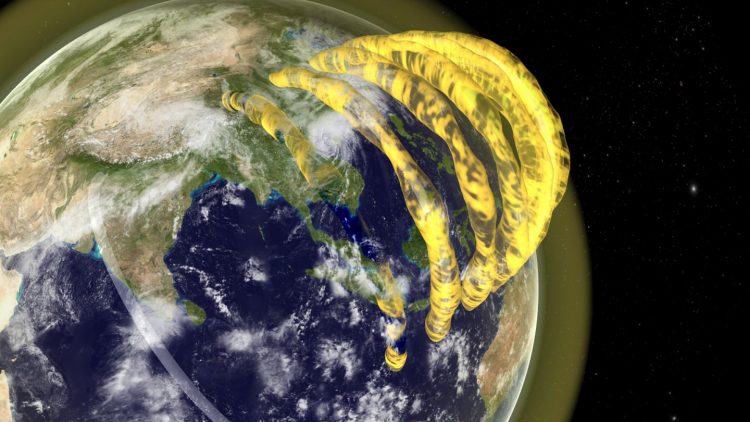Cosmic cinema: Astronomers make 3-D movies of plasma tubes

This is an artist's impression of tubular plasma structures in the Earth's magnetosphere, 600 kilometres above the ground. Credit: CAASTRO/Mats Bjorkland
“For over 60 years, scientists believed these structures existed but by imaging them for the first time, we've provided visual evidence that they are really there,” said Cleo Loi of the ARC Centre of Excellence for All-sky Astrophysics (CAASTRO) and School of Physics at the University of Sydney in Australia.
Ms Loi is the lead author on this research, undertaken as part of her award-winning undergraduate thesis and recently published in Geophysical Research Letters. In collaboration with international colleagues, she identified the structures.
“The discovery of the structures is important because they cause unwanted signal distortions that could, as one example, affect our civilian and military satellite-based navigation systems. So we need to understand them,” Ms Loi said.
The region of space around the Earth occupied by its magnetic field, called the magnetosphere, is filled with plasma that is created by the atmosphere being ionised by sunlight.
The innermost layer of the magnetosphere is the ionosphere, and above that is the plasmasphere. They are embedded with a variety of strangely shaped plasma structures including, as has now been revealed, the tubes.
“We measured their position to be about 600 kilometres above the ground, in the upper ionosphere, and they appear to be continuing upwards into the plasmasphere. This is around where the neutral atmosphere ends, and we are transitioning to the plasma of outer space,” explained Ms Loi.
Using the Murchison Widefield Array (MWA), a radio telescope located in the Western Australian desert, Ms Loi found that she could map large patches of the sky and even exploit the MWA's rapid snapshot capabilities to create a movie – effectively capturing the real-time motions of the plasma.
“We saw a striking pattern in the sky where stripes of high-density plasma neatly alternated with stripes of low-density plasma. This pattern drifted slowly and aligned beautifully with the Earth's magnetic field lines, like aurorae,” Ms Loi said.
“We realised we may be onto something big and things got even better when we invented a new way of using the MWA.”
The MWA consists of 128 antenna 'tiles' spread over an area roughly three by three kilometres that work together as one instrument – but by separating the signals from tiles in the east from the ones in the west, the astronomers gave the MWA the power to see in 3D.
“This is like turning the telescope into a pair of eyes, and by that we were able to probe the 3D nature of these structures and watch them move around,” said Ms Loi.
“We were able to measure the spacing between them, their height above the ground and their steep inclination. This has never been possible before and is a very exciting new technique.”
This ability adds yet another accolade to the MWA's name after it had already proven its worth as a powerful precursor instrument to the Square Kilometre Array (SKA), and now the MWA's 3D vision has the potential to provide many more in-depth analyses of the formation of plasma structures.
“It is to Cleo's great credit that she not only discovered this but also convinced the rest of the scientific community. As an undergraduate student with no prior background in this, that is an impressive achievement,” said Ms Loi's supervisor Dr Tara Murphy, also of CAASTRO and School of Physics at the University of Sydney.
“When they first saw the data, many of her senior collaborators thought the results were literally 'too good to be true' and that the observation process had somehow corrupted the findings, but over the next few months, Cleo managed to convince them that they were both real and scientifically interesting.”
###
Ms Loi has been awarded the 2015 Bok Prize of the Astronomical Society of Australia for her work.
Media Contact
All latest news from the category: Physics and Astronomy
This area deals with the fundamental laws and building blocks of nature and how they interact, the properties and the behavior of matter, and research into space and time and their structures.
innovations-report provides in-depth reports and articles on subjects such as astrophysics, laser technologies, nuclear, quantum, particle and solid-state physics, nanotechnologies, planetary research and findings (Mars, Venus) and developments related to the Hubble Telescope.
Newest articles

Combining robotics and ChatGPT
TUM professor uses ChatGPT for choreographies with flying robots. Prof. Angela Schoellig has proved that large language models can be used safely in robotics. ChatGPT develops choreographies for up to…

How the Immune System Learns from Harmless Particles
Our lungs are bombarded by all manner of different particles every single day. Whilst some are perfectly safe for us, others—known as pathogens—have the potential to make us ill. The…

Biomarkers identified for successful treatment of bone marrow tumours
CAR T cell therapy has proven effective in treating various haematological cancers. However, not all patients respond equally well to treatment. In a recent clinical study, researchers from the University…





















